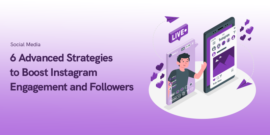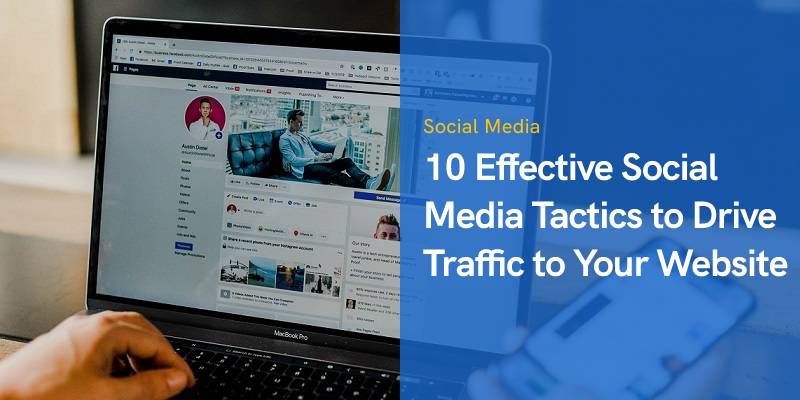
10 Effective Social Media Tactics to Drive Traffic to Your Website
Table of Contents
ToggleNo matter the nature of your online business, generating web traffic is by far the most important factor in increasing your sales, thus making your business more successful.
Although there are various ways to increase web traffic, social media is favored by many entrepreneurs for several reasons.
Why Social Media?
The obvious uptake of social media worldwide is undeniable and is projected to register 4.41 billion users by 2025 as shown in the image below.
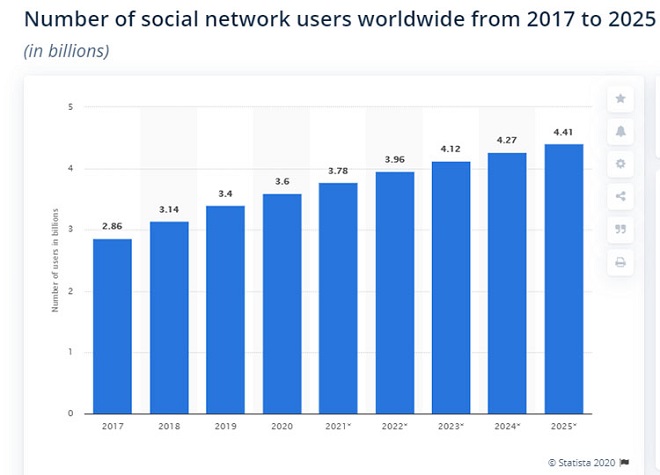
Caption: Number of Social Media Users Worldwide (Source: Statista)
Also, social media marketing is inexpensive. You can even get started for free. Social media platforms are great to help build ‘followers’, an audience that you can engage with multiple times on a long-term basis.
Last but not least, social media helps people who otherwise might never hear of your business discover you, thus increasing your reach and a total number of potential customers.
Simply put, social media is a cost-effective way to help build brand recognition, foster a community around your business and grow your bottom line.
How to Use Social Media to Drive Traffic to Your Website?
To drive more traffic to your website, you’ll have to combine social media and your website content in the right way. So, if either were to be lacking, you won’t be able to drive traffic reliably to your website and generate sales from it. Remember that promoting your business with the right content and social media is a single integrated process.
Let’s look at the following tactics that you can carry out to leverage on social media to help increase web traffic to your website in an effective way:
Get Active and Remain Active on Social Media
This is the first thing you must do. Set up your social accounts and apply the Social Media Rule of Thirds. You can refer to the image below.
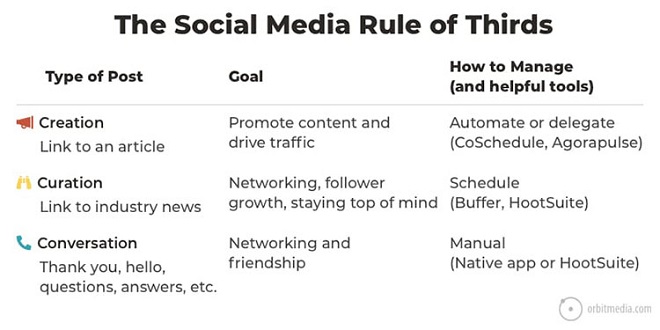
(Source: Orbitmedia)
Fill in and complete your profile. This is crucial as this is the first thing people see when they click your social media page. No matter which social media you use, the profile will show information about your business. Drop a link to your website here. This will help drive traffic to your website.
An example is shown below for H&M Facebook page:
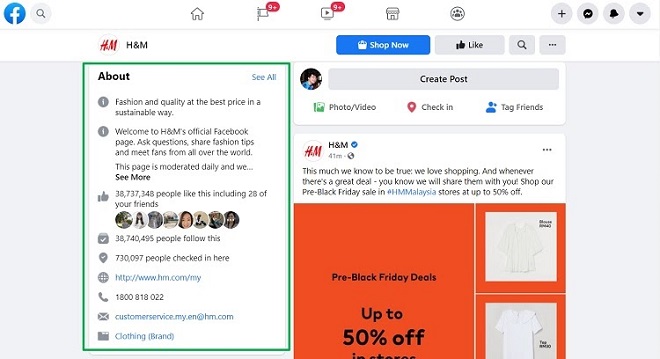
(source: H&M Facebook page)
Social media drives 31% of all referral traffic. So, get a slice of this action by adding backlinks to your website.
If visitors are intrigued by what they read, they’ll likely be interested to find out more. You must ensure there’s a link to your website’s homepage on ALL of your social media profiles.
Promote Your Blog Content
Most websites nowadays incorporate a blog and much of your blog relies on the quality of the content presented to your audience. So, it is natural that you’d put tons of effort into writing quality content for your blog. But what’s the point of creating awesome content if people aren’t going to consume it?
This is where you need to promote your posts on social media. Studies have shown that those who create 15 blog posts per month and share this through social media, can produce an average of 1,200 new leads per month. So, you need to start promoting your posts at any point, with any piece of quality content.
Do so by creating a social media schedule that promotes your older content. There are many social media marketing tools available.
You can promote your content via a social media scheduling tool like Planly or Buffer.
A good practice would be to create a document (for each blog post) that contains an additional 5-10 older blog post titles. Add these to the social scheduling tool along with the URL of your article. This can help drive traffic back to the older blog content.
You can also repurpose your blog posts to get more use out of them:
- Craft different and catchy snippets for your article
- Interact with your target audience by posting questions that are relevant to the post
- Vary your choice of images
- Alter the headline of your article every 2-3 months
Do the above and you’ll keep your blog fresh, interesting and thus attract more audience to your website.
Post on Social Media at The Strategic and Opportune Times
You need to be active when your audience is active. This helps heaps to increase your visibility. So, look into when your target audience is most active, aka their ‘peak time.’ However, you can follow the following general guidelines when it comes to posting on social media at your audience's peak times.
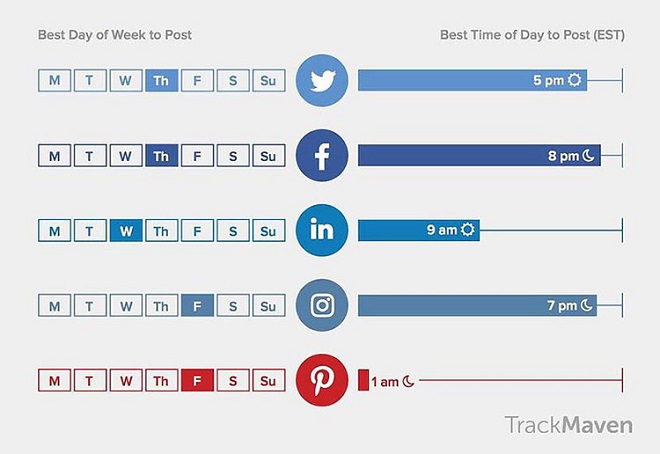
Caption: Best Time to Post on Social Media (Source: Entrepreneur)
Remember that you’ll need to keep testing the waters to check out the times that drive the most engagements and click-throughs. You then make adjustments accordingly.
Or you can use Followerwonk which is a tool that can help with this. It basically lets you know the time of day your audience is most active, allowing you to tailor your posting schedule to be around their daily routines.
Once you have this valuable information at hand, optimize your posting schedule around your followers' activities. Choose and schedule posts that appeal to your audience most during these intervals of time. Finally, try and be active when your audience is online.
Add Social Share Buttons on Your Website
You’ll need to know how social media can be connected to your website to boost user engagement. You mustn’t forget to make it easy for people to share your content on social media.
This can help you go that extra mile. Since users will share posts on social media sites especially when they come across something they enjoy and find intriguing, this method does improve your online exposure.
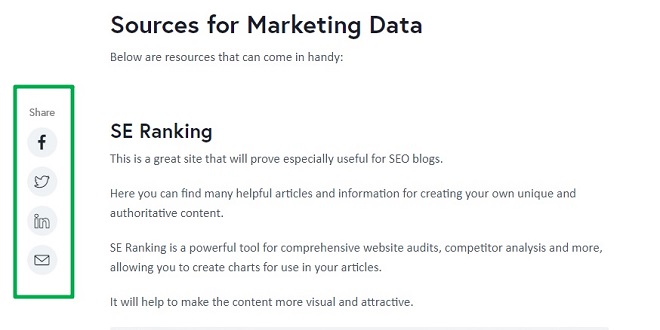
(Source: Webnus)
Embed social sharing on your blog. This is clearly shown in the image above. The buttons allow easy sharing of your content on social media.
The easiest would be to set up a WordPress social media plugin for your website. There are some that even display the number of shares earned by each post. If you make this information available to your audience, it could help build trust and lead to higher conversion rates later in the buying cycle.
Use a Social Media Calendar
Using a Social Media Calendar is a systematic way to help you get more click-throughs on social media. This calendar provides information to help you understand:
- The reason your audience shares or doesn’t share your content
- The type of content people prefer etc
With this information at hand, you’ll be able to strategize better. You’ll know what type of content works and also stop over-sharing the same type of content. A simple spreadsheet can get you started quickly on this. This can help improve the chances of your posts getting liked and shared, thus improve traffic to your blog.
Optimize your CTAs (Calls-to-Action)
Calls-to-action literally tell a user exactly what you want them to do. They’re very useful to convince your audience to click-through to your website on social media. You can increase the number of clicks your social media shares receive by using CTAs in your post.
According to research, adding CTAs to your Facebook page can increase the click-through rate by 285%. However, you need to make sure that these added CTAs are relevant and will benefit your audience.
Simple phrases like ‘Click Here’, ‘Read More’, ‘Find out More’ or ‘Visit Our Site’ are simple yet powerful enough to persuade readers to actually click on the content you’re sharing. This in turn drives up your referral traffic from each platform.
So, take down a list of CTAs you want to test on your social media profiles. Use each one at least 5 times. Record the metrics found for each. Look into the engagement, link clicks and profile visits. This will let you know which works best for your audience.
Use Paid Social Advertising
Not everyone would have the marketing budget for social advertising. However, this is undoubtedly an effective way to reach new people who haven’t yet heard of your website. So, if you do have the marketing budget, social advertising is worth looking into.
Overall, when it comes to a Facebook campaign, the average cost-per-click (CPC) ranges from $0.45 to $0.70 per click. As the image below shows, you’ll notice that the average click-through rate for Facebook Ads across industries is at 0.9%.
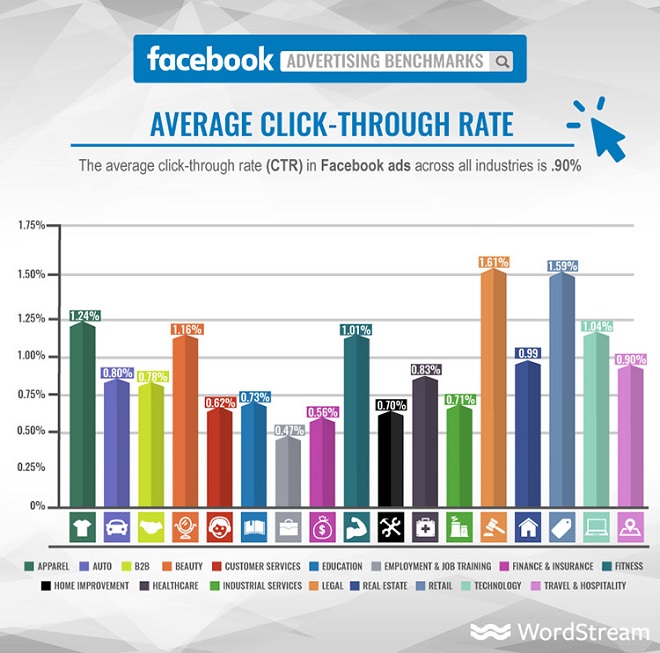
Caption: Average Click-Through Rate for Facebook (Source: Wordstream)
Let’s now look at Facebook Ads. You’ll need to have a ‘Saved Audience’ list, which basically is a list of people who are likely to be interested in what you have to offer.
Know who is interested in what and assign a budget depending on the size of your audience. Optimize your campaign and gear your social advertising towards your ideal customer’s stage in the buying journey.
It is better to promote a link to your blog posts to cold leads rather than a product they’ve never heard of and are unfamiliar with.
Use CTA and ensure your links are relevant to what your audience would be looking for. When you do this, Facebook Ads could be your business’s biggest source of referral traffic.
Research Your Competitors
This is basically you benchmarking on your competitors. It is a great tactic for improving the traffic you get from social media. In short, you’ll have to spy on your competitors. See what they are doing that is working and then try to replicate it. You can look into several social media competitor analysis tools, such as Hootsuite or Sprout Social.
Run the tool and based on the findings, look for:
- The keywords they’re using
- Who they’re following
- The social networks they’re on
- The size of their audience
- Their posting frequency
Analyze their profiles and content. Look for things such as:
- If they’re posting relevant and up-to-date content
- If their customer service is bad or good
- The kind of images they’re using
- Any unique methods they’re using to promote themselves
Remember that monitoring any changes in your competitors’ social media is also a must as this helps you to stay on top of things. With this, you’ll be able to close the gaps and do something effective on social media to get more traffic to your website.
Focus on Sharing Visual Content
Visual content is 40 times more likely to get shared on social media than any other type of content.
Remember that when a user scrolls endlessly through a social media feed, chances for the user to miss content that might be interesting or otherwise helpful are high.
So you need to have outstanding and striking visual content that could help capture the eyes of your visitors.
Also, tweets with images do receive 150% more retweets than those without.
So, if you use visual graphics on Twitter, you could position your content along with your website link to more ideal customers. You can use Graphs, Charts, GIFs, Videos, Photos and Animations.
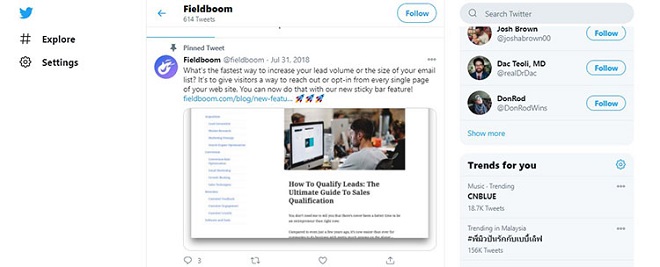
(Source: Fieldboom Twitter)
The above is a good example of Fieldboom using visuals in their social posts, which link to blog posts to drive website traffic. So, imagine doing this on all your visual content sharing platforms, you’ll soon see an improvement in social traffic.
Engage With Your Audience
Social media is all about being ‘social’. You need to consistently engage directly with your audience to build your presence. When you successfully do so, this could be very effective in driving traffic to your website and also improve your audience’s opinion of your business as a brand.
A simple task of answering questions and obtaining feedback in real-time can improve the experience people have with your brand. For example, you can participate more in Twitter chats by looking for topics and chats relevant to your business. Once you found one, answer relevant questions and help people solve problems.
Your objective is to contribute to the conversation. People will then be interested in what you have to say and impressed by your authority. Chances are they will likely click-through to your profile to learn more about your business.
Always Respond to Tweets and Comments
Never ignore tweets and comments related to you and your business. If you do, your business can easily miss the mark. You need to strike the oven when it’s hot. When they’re interested, leverage on this and respond to show your interest. This demonstrates your business’s sincerity and value.
Search for Relevant Hashtags
If you’re an authority in a certain industry, pay attention to hashtags and discussions. When sharing your own content, use relevant hashtags while sparking up conversations with people who include them in their social media posts. Remember that since each of these hashtags can create opportunities to link to your website, it’s important that they are relevant and genuine.
Contribute to Relevant Forums
You’ll find many forums that are basically online communities that come together to ask questions, offer knowledge and share links to content that’s relevant. These forums range across the board covering various industries. You can find many in Quora and Reddit.
The people participating in these forums want to learn more, therefore they dedicate their time and effort to these forums. So, you can position your content to these people in such forums, in order to help drive traffic to your website. Make sure they are relevant.
Conclusion
Now that you’re armed with these social media tactics, you can implement them into your social media strategy. You can start smaller and try a few of them first.
Monitor the results and any impact on your web traffic. You should be seeing increased traffic to your website, then try the others.
With a complete and fresh social media profile, your content will surely be read and shared, increasing your visibility. You’re well on your way to increasing more traffic to your website.
Recommended Posts
![How to Upload [YouTube Shorts] to Grow Your Channel Easily](https://webnus.net/wp-content/uploads/2023/01/How-to-Upload-YouTube-Shorts-to-Grow-Your-Channel-Easily-270x135.jpg)
How to Upload [YouTube Shorts] to Grow Your Channel Easily
January 15, 2023


